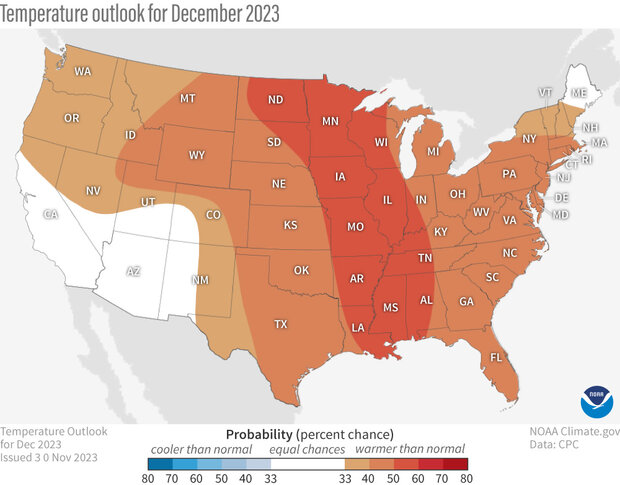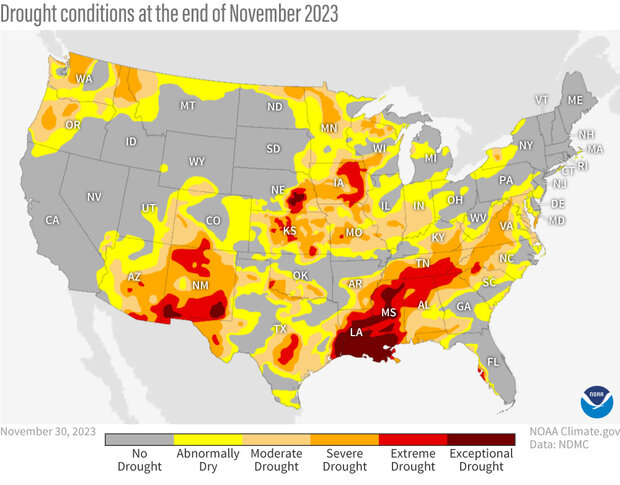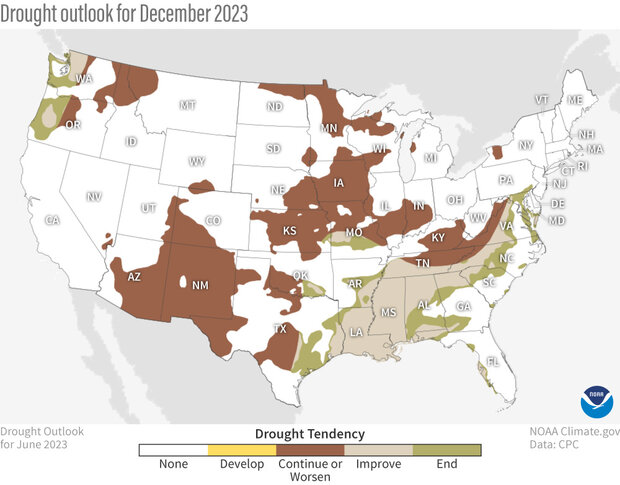U.S. climate outlook for December 2023
The last week of November saw a significant snowstorm impact the central and northern Rockies as well as the central Plains and around the Great Lakes. This was then followed by well below normal temperatures over the eastern half of the nation, with freezing temperatures observed all the way to the Gulf Coast. As we head into the first month of meteorological winter, was this event a harbinger of the month ahead, or will temperatures revert to a milder pattern, more typical of El Niño? Let’s see what NOAA's Climate Prediction Center (CPC) predicts for the month ahead.
The U.S. temperature outlook for December 2023 (view Alaska), showing places where a much warmer than average December is favored (orange to red). White areas indicate that there are equal chances for a warm, cool, or near-average December. For more details on how to interpret these maps, read our explainer Understanding NOAA's monthly climate outlooks. Map by NOAA Climate.gov, based on data from the Climate Prediction Center.
On November 30, CPC released its updated monthly climate outlooks for temperature, precipitation, and drought across the United States for December 2023. The temperature outlook favors well above normal temperatures across much of the nation, with the exception of the Southwest. The precipitation outlook favors well above average precipitation (rain and/or snow) in the Pacific Northwest, in parts of the central and southern Plains, in the Southeast, and along much of the Eastern Seaboard, with well below average precipitation only favored in parts of the northern Plains.
The U.S. precipitation outlook for December 2023 (view Alaska), showing places where a much wetter than average December is favored (greens) and where a much drier than average December is favored (browns). White areas indicate that there are equal chances for a wet, dry, or near-average December. For more details on how to interpret these maps, read our explainer Understanding NOAA's monthly climate outlooks. Map by NOAA Climate.gov, based on data from the Climate Prediction Center.
Below, I’ll discuss the basis for the CPC outlooks as well as highlight additional important information about them. I’ll also discuss the current state of drought, how it changed during November, and the drought outlook for December. And before we dig into the specifics of the outlooks, just a gentle reminder that the colors on the temperature and precipitation outlook maps only provide information about the most likely outcome, but other outcomes are always possible, just less likely to occur. More details about interpreting the outlooks can be found here.
The updated outlooks were produced considering the Week 1 forecast from the Weather Prediction Center (WPC), and CPC’s own Week 2 and Week 3-4 outlooks. Other tools that forecasters considered this month were various longer-range forecast models such as the Global Ensemble Forecast System (GEFS), the Climate Forecast System (CFSv2), and products derived from these models. El Niño continued to strengthen during November across the tropical Pacific and was again considered as a dominant teleconnection for the outlooks during December. But the Madden-Julian Oscillation (MJO)—a conjoined area of heavy rains and clear, calm skies that travel the tropics together as a couple—was active over the Indian Ocean at the end of November. Since the MJO is expected to remain active and progress towards the Maritime Continent and then the west Pacific, forecasters also considered potential MJO impacts.
Temperature outlook
The December temperature outlook favors well above average temperatures across most of the country, with the exception of much of California, the Southwest, and Maine, where equal chances (EC) of above-, near-, or below-normal temperatures are predicted. Well below normal temperatures are not favored anywhere during December in the continuous United States (southern Alaska does have a slight tilt toward below-average temperatures). The highest odds for a warmer-than-average December are in the middle of the nation, where probabilities exceed 50%. Elsewhere, odds are only between 33-50%, which means the outlooks leans only slightly toward warmth
Temperatures across the northern U.S. are often above normal during El Niño winters, and it appears that this winter will start that way too. While the outlook has a greater than 50% chance of above-average temperatures in the northern Plains and western Great Lakes for December as a whole, the outlooks for the first 2 weeks of the month favor above-average with even greater confidence (60-80%). The Week 3-4 outlook (released on November 24, 2023) also favored above-average temperatures in that region.
Finally, with the MJO currently located over the Indian Ocean, lagged composites (maps of delayed impacts based on historical data) imply ridging (the build-up of high pressure) and above-average temperatures over the central part of the nation, which potentially shifts into the eastern part of the nation later in the month. In the East, near-average temperatures during the first 10 days of the month are expected to be overwhelmed by above-normal temperatures afterward, particularly if the MJO remains active. In contrast, the “Equal Chances” forecast in California and across the Southwest arises due to uncertainty linked to the MJO, where model forecasts indicate a fairly changeable pattern.
Precipitation outlook
Well above average precipitation during December is favored in the Pacific Northwest, and in a region extending from the central and southern Plains through the Southeast to along the East Coast as far north as Connecticut. Greatest probabilities are along the Washington Coast (>60%), where an atmospheric river early in the month is predicted to douse the region with more than 10 inches of precipitation. Probabilities for above-average precipitation exceed 50% in parts of the Southeast, where precipitation amounts of 1-3 inches are predicted during the first days of the month. Above-average precipitation is also favored during the Week-2 and Week 3-4 outlooks, consistent with the background El Niño state.
In contrast, below-normal precipitation is only favored in parts of the northern Great Plains and Upper Great Lakes, but with modest probabilities (<50%). Climatological (normal) precipitation amounts during December are fairly low in this region, so there is greater uncertainty for below-average than for areas in the Southeast and Northwest, as even smaller amounts of precipitation can result in near-normal precipitation.
Drought status
Drought conditions across the contiguous United States as of November 30, 2023. Extreme (red) and exceptional (dark red) drought was confined to the Southwest, the heart of the Great Plains, and the South. NOAA Climate.gov map, based on data from the U.S. Drought Monitor Project. For more details on drought, visit Drought.gov.
During November, the amount of drought across the United States decreased slightly, with the percent of the contiguous U.S. in drought decreasing from 40% near the end of October to around 36% by the end of November. Additionally, the percent of the country in the two most intense categories (D3-D4, representing extreme and exceptional drought) decreased slightly, from about 9% to just under 8%.
Much of the drought improvement occurred throughout Texas, as improvement of up to 4 classes was recorded in the northeastern part of the state, and with lesser improvements of 1-2 classes elsewhere. Some limited drought improvement was also observed in the Pacific Northwest and northern Rockies, generally on the scale of 1-2 classes. In contrast, drought degradation was seen in much of the Southeast and southern mid-Atlantic, generally 1-2 classes, but up to 3 classes in eastern Kentucky. Drought also slightly degraded in the Southwest as well as in Illinois.
Drought outlook
The December 2023 drought outlook for the contiguous United States (view Alaska, Hawaii, and Puerto Rico). Yellow areas are likely to see drought develop. Brown areas are likely to see drought persist. Tan means drought is likely to improve at least 1 category, and green means drought is likely to end. NOAA Climate.gov map, based on data from NOAA Climate Prediction Center.
Not surprisingly, the drought outlook for December generally favors improvement and/or removal in those regions favored to experience well above average precipitation, with drought persistence in other parts of the country. In particular, drought removal is expected in parts of the Pacific Northwest (improvement but not removal for areas in severe drought), with persistence in the northern Rockies, as precipitation primarily builds mountain snowpack in this area, which has begun the season below-average.
Drought improvement is also predicted in the Southeast, with a heavy precipitation event in early December favored to bring some initial drought relief to this region. Forecasts at longer time ranges (Week-2, Week 3-4, and monthly) all favor a continued wet pattern. This is also consistent with El Niño conditions, which typically promotes an active jet stream across the southern U.S. Drought improvement is also expected in the mid-Atlantic, as recent wetter conditions in that region are forecast to continue through December. New drought development during December is not predicted for any part of the nation.
To read the entire discussion of the monthly climate outlooks from the Climate Prediction Center, check out their website.



